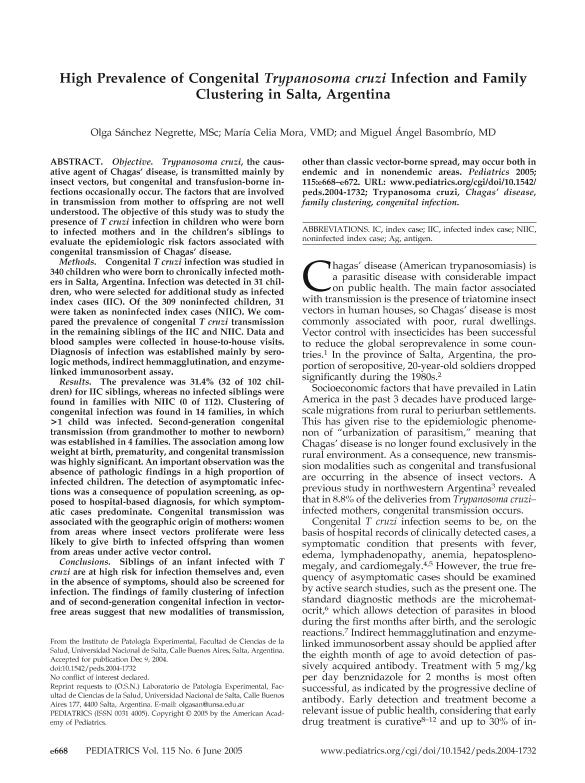Mostrar el registro sencillo del ítem
dc.contributor.author
Sánchez Negrette, Olga

dc.contributor.author
Mora, Maria Celia

dc.contributor.author
Basombrío, Miguel Ángel Manuel

dc.date.available
2018-04-24T17:35:31Z
dc.date.issued
2005-06-06
dc.identifier.citation
Sánchez Negrette, Olga; Mora, Maria Celia; Basombrío, Miguel Ángel Manuel; High Prevalence of Congenital Trypanosoma cruzi Infection and Family Clustering in Salta, Argentina; American Academy of Pediatrics; Pediatrics; 115; 6; 6-6-2005; 668-672
dc.identifier.issn
0031-4005
dc.identifier.uri
http://hdl.handle.net/11336/43258
dc.description.abstract
Objective.Trypanosoma cruzi, the causative agent of Chagas’ disease, is transmitted mainly by insect vectors, but congenital and transfusion-borne infections occasionally occur. The factors that are involved in transmission from mother to offspring are not well understood. The objective of this study was to study the presence of T cruzi infection in children who were born to infected mothers and in the children's siblings to evaluate the epidemiologic risk factors associated with congenital transmission of Chagas' disease.
Methods. Congenital T cruzi infection was studied in 340 children who were born to chronically infected mothers in Salta, Argentina. Infection was detected in 31 children, who were selected for additional study as infected index cases (IIC). Of the 309 noninfected children, 31 were taken as noninfected index cases (NIIC). We compared the prevalence of congenital T cruzi transmission in the remaining siblings of the IIC and NIIC. Data and blood samples were collected in house-to-house visits. Diagnosis of infection was established mainly by serologic methods, indirect hemmagglutination, and enzyme-linked immunosorbent assay.
Results. The prevalence was 31.4% (32 of 102 children) for IIC siblings, whereas no infected siblings were found in families with NIIC (0 of 112). Clustering of congenital infection was found in 14 families, in which >1 child was infected. Second-generation congenital transmission (from grandmother to mother to newborn) was established in 4 families. The association among low weight at birth, prematurity, and congenital transmission was highly significant. An important observation was the absence of pathologic findings in a high proportion of infected children. The detection of asymptomatic infections was a consequence of population screening, as opposed to hospital-based diagnosis, for which symptomatic cases predominate. Congenital transmission was associated with the geographic origin of mothers: women from areas where insect vectors proliferate were less likely to give birth to infected offspring than women from areas under active vector control.
Conclusions. Siblings of an infant infected with T cruzi are at high risk for infection themselves and, even in the absence of symptoms, should also be screened for infection. The findings of family clustering of infection and of second-generation congenital infection in vector-free areas suggest that new modalities of transmission, other than classic vector-borne spread, may occur both in endemic and in nonendemic areas.
dc.format
application/pdf
dc.language.iso
eng
dc.publisher
American Academy of Pediatrics

dc.rights
info:eu-repo/semantics/openAccess
dc.rights.uri
https://creativecommons.org/licenses/by-nc-sa/2.5/ar/
dc.subject
Trypanosoma Cruzi
dc.subject
Chagas Disease
dc.subject
Family Clustering
dc.subject
Congenital Infection
dc.subject.classification
Medicina Tropical

dc.subject.classification
Ciencias de la Salud

dc.subject.classification
CIENCIAS MÉDICAS Y DE LA SALUD

dc.title
High Prevalence of Congenital Trypanosoma cruzi Infection and Family Clustering in Salta, Argentina
dc.type
info:eu-repo/semantics/article
dc.type
info:ar-repo/semantics/artículo
dc.type
info:eu-repo/semantics/publishedVersion
dc.date.updated
2017-11-03T19:08:50Z
dc.journal.volume
115
dc.journal.number
6
dc.journal.pagination
668-672
dc.journal.pais
Estados Unidos

dc.description.fil
Fil: Sánchez Negrette, Olga. Universidad Nacional de Salta. Facultad de Cs.de la Salud. Laboratorio de Patología Experimental; Argentina
dc.description.fil
Fil: Mora, Maria Celia. Consejo Nacional de Investigaciones Científicas y Técnicas. Centro Científico Tecnológico Conicet - Salta. Instituto de Patología Experimental. Universidad Nacional de Salta. Facultad de Ciencias de la Salud. Instituto de Patología Experimental; Argentina
dc.description.fil
Fil: Basombrío, Miguel Ángel Manuel. Consejo Nacional de Investigaciones Científicas y Técnicas. Centro Científico Tecnológico Conicet - Salta. Instituto de Patología Experimental. Universidad Nacional de Salta. Facultad de Ciencias de la Salud. Instituto de Patología Experimental; Argentina
dc.journal.title
Pediatrics

dc.relation.alternativeid
info:eu-repo/semantics/altIdentifier/url/http://pediatrics.aappublications.org/content/115/6/e668
dc.relation.alternativeid
info:eu-repo/semantics/altIdentifier/doi/https://dx.doi.org/10.1542/peds.2004-1732
Archivos asociados
